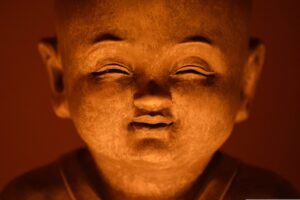Sikh Dharma in the Western Hemisphere
Sikh Dharma of the Western Hemisphere is an organization founded by Sri Singh Sahib Harbhajan Singh Khalsa Yogiji more than 35 years ago that has had a remarkable impact on the culture of the west. For the first time in history, Sikh philosophy and lifestyle has spread in unprecedented numbers to people outside the boundaries of the Punjab, India. In the heavy pressure and hectic pace of life in the western world, the simple peace of Sikhism has found fertile ground to grow and emerge as a religion for the modern world.
Babanian Kahanian Putt Sputt Karen
Je Satgur Bhave Su mann lein seyee karam Karen (951)
The inspiration behind this unique movement in the west, Harbhajan Singh Puri was born on August 26, 1929 in Gujaranwala, a part of Punjab which is now in Pakistan. Even as a child, he had a mind and a temperament that was far above his peers. His first teacher was his grandfather, Bhai Fateh Singh, who guided him as a young boy. Together they would sit and meditate, the young child learning the ancient ways from his saintly grandfather:
The stories of one’s ancestors make the children better children. They accept what is pleasing to the Will of the True Guru and act accordingly.
When he was still young, he went to study from Sant Hazara Singh. This holy man was renowned throughout the land as a strict teacher and an unsurpassed master of Kundalini Yoga. Young Harbhajan Singh studied with earnest effort, and became a master of Kundalini Yoga. at the remarkable age of 16. The gift of this ancient science was to serve him his entire life and play a critical role in the spread of Sikhism in the West.
Yogi Bhajan (as he came to be known later throughout his life) left India in September 1968 to take a job of teaching yoga at Toronto University. Within a few months, Yogi Bhajan took a trip to visit Los Angeles and delivered his first lecture there on January 5th, 1969. His words dramatically awakened the young people who heard him. He brought them an inspiring message of hope and truth. He said, “Each person must deeply understand why he is a human being and what it means to be a human being. Once you have seen the joy of being a human being and have enjoyed the beauty of it, this is an experience of wisdom. You have a right to be Healthy. You have a right to be Happy. You have a right to be Holy. It is your birthright!” With that premise, he started the 3HO Foundation (Happy, Healthy, Holy Organization) and took daily classes in Kundalini Yoga.
People flocked to Yogi Bhajan’s classes to learn Kundalini Yoga and their lives began to change almost immediately. As a result of Yogi Bhajan’s classes, their lives became spiritually charged with a new meaning and a new purpose. They were so enchanted with the path of spiritual awakening that they wholeheartedly pursued Kundalini Yoga and Yogi Bhajan taught with boundless energy.
The vision that brought Yogi Bhajan to teach in the West was a deep faith that Sikhism was a vital key to the future of humanity. For the most part, people were not looking for a new religion when they came to his Kundalini Yoga classes. But as their lives began to change and their minds became receptive, they yearned to experience the spiritual nature of life. It wasn’t long before the Yoga students wanted to know about Sikhism. They had listened to the stories Yogi Bhajan told about the brave and glorious Sikh saints and heroes, and they too longed to belong to that glorious heritage. Guru Gobind Singh’s message touched their hearts and struck a cord of deep harmony within their souls:
Saach kahun sun leh sabhe
Jin prem kio tin hi prabh paio (Guru Gobind Singh)
I speak the Truth Listen everyone! Those who love God, shall find him.
In 1970, two young men wanted to formally become Sikhs and they pledged themselves before Sri Guru Granth Sahib. This was the beginning of an avalanche of young men and women who made life-changing decisions to become Sikhs and follow the path shown by Nanak.
The Sikh leadership in Amritsar was stunned! The flower of Sikhism was blooming afresh in the west, far from the borders
of the Punjab. In acknowledgment of his service to humanity, the Akal Takht honored Yogi Bhajan. In front of thousands, he was presented with a saropa and the title “Bhai Sahib” for his missionary work in the west. Sant Fateh Singh, President of the Shiromani Akali Dal and Sant Chanan Singh, president of the SGPC said, “Since this one Harbhajan Singh will create many Singh Sahibs. We will call him Sri Singh Sahib!” And so was he known from that day onwards.
The Sri Singh Sahib returned to the United States with renewed inspiration. It was as if these new Sikhs were awakened from amnesia into an identity that was theirs right from the beginning. The Sri Singh Sahib often said to his students, “God is not found only on the mountain tops, He lives down everywhere, even in your cozy homes.” A cozy home is where God’s Name is remembered in a loving environment and where basic values are passed from generation to generation. The cornerstone of a cozy home is a woman who lives with her spiritual values intact. To foster this precious identity, in 1975, the Sri Singh Sahib taught Sikh values to women in the first Khalsa Women’s Training Camp. This tradition carries on each summer to inspire and rejuvenate the Khalsa women of the west with classes in Sikhism, spirituality, raising children and being a woman in all nobility. This led to the upsurge of a whole new generation of bold and strong Sikhs in the Western families. Sikh Dharma opened schools in the United States and India to educate these young people in a spiritual environment.
To ensure that the growth of Sikhism in the West was a living reality, financial stability was required. So, Sri Singh Sahib worked to establish successful organizations and business. One of the most successful business is Akal Security, founded by Gurutej Singh Khalsa. Trained as a policeman, Gurutej Singh was not able to take a job promised to him because of his turban and full, flowing beard. Gurutej Singh refused to sheer off his beard, taking strength in the words of Guru Gobind Singh ji,
Jab lag khalsa rahe niara
Tab lag tej deeo mein sara (Guru Gobind Singh)
So long as the Khalsa remain distinct, I will give my strength to them.
With encouragement and guidance from Sri Singh Sahib, he started a private security company. Sri Singh Sahib told him, “Name this business Akal, and some day the police will come and learn from you!” Those words have come true as Akal Security now employees more than 15,000 people across the United States, bringing employment and prosperity to Sikh Dharma.
After thirty five years of weaving in and through the fabric of Sikhism, Sikh Dharma of the Western Hemisphere has earned a place in history. Classes in Sikhism are taught throughout
America and Europe, continuing to instill in thousands of people the simple and graceful technology of Sikh Dharma. Westerners who have become Sikhs and their generations, are seen everywhere in their white turbans and are accepted as part of the continually changing panorama of the Khalsa.
Sri Singh Sahib merged with the Divine on October 6, 2004. He left behind tens of thousands of students, and a financially independent and secure organization. However, he took no credit for the renewal of Sikhism in the west. He said, “This Dharma is established in the West by the Will of God and by the Grace of the Guru. Neither you nor I have played any part whatsoever. It is the destiny of the planet earth for which interrogatively, questioningly, and demonstrably the penetrating energy will prevail into the psyche, and the birth of the Khalsa shall be celebrated. There is nothing a human has to say or do.”

Essence of Sikhi
Unconditional dedication to the Guru is the prime demand for spiritual realization. Doing Guru’s service and seeking rewards for the same is bound to bring disillusionment. Ever-willing, ever-ready to act as the Guru bids, is the attitude of a learner – a Sikh. Simran is the highest mode of Seva because in simran one is ever in the presence of the Guru. The Shabad of the Guru is the subject of contemplation as well as the object of loving adoration. Thus we transcend our finite selves. Our lives become a humble offering to the Divine in whatever we may be engaged in life to do.












